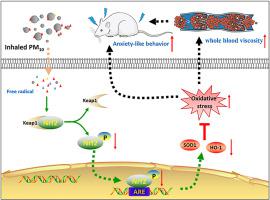当前位置:
X-MOL 学术
›
Free Radical Bio. Med.
›
论文详情
Our official English website, www.x-mol.net, welcomes your feedback! (Note: you will need to create a separate account there.)
Chronic exposure to PM10 induces anxiety-like behavior via exacerbating hippocampal oxidative stress
Free Radical Biology and Medicine ( IF 7.4 ) Pub Date : 2024-03-06 , DOI: 10.1016/j.freeradbiomed.2024.02.025 Jie Cheng , Jian Sun , Rui Niu , Xiaoqing Wang , Guilin Hu , Fan Li , Kunrong Gu , Hao Wu , Yuanchun Pu , Fanqi Shen , Hao Hu , Zhenxing Shen
Free Radical Biology and Medicine ( IF 7.4 ) Pub Date : 2024-03-06 , DOI: 10.1016/j.freeradbiomed.2024.02.025 Jie Cheng , Jian Sun , Rui Niu , Xiaoqing Wang , Guilin Hu , Fan Li , Kunrong Gu , Hao Wu , Yuanchun Pu , Fanqi Shen , Hao Hu , Zhenxing Shen

|
As one of the most environmental concerns, inhaled particulate matter (PM) causes numerous health problems. However, the associations between anxiety behavior and toxicity caused by PM have rarely been reported so far. To investigate the changes of behavior after PM exposure and to identify the potential mechanisms of toxicity, PM samples (with doses of 15 mg/kg and 30 mg/kg) were intratracheally instilled into rats to simulate inhalation of polluted air by the lungs. After instillation for eight weeks, anxiety-like behavior was evaluated, levels of oxidative stress and morphological changes of hippocampus were measured. The behavioral results indicated that PM exposure induced obvious anxiety-like behavior in the open field and elevated plus maze tests. Both PM concentrations tested could increase whole blood viscosity and trigger hippocampal neuronal damage and oxidative stress by increasing superoxide dismutase (SOD) activities and malondialdehyde levels, and decreasing the expressions of antioxidant-related proteins (e.g., nuclear factor erythroid 2-related factor 2 (Nrf2), SOD1 and heme oxygenase 1). Furthermore, through collecting and analyzing questionnaires, the data showed that the participants experienced obvious anxiety-related emotions and negative somatic responses under heavily polluted environments, especially PM being the main pollutant. These results show that PM exposure induces anxiety-like behavior, which may be related to suppressing the Nrf2/Keap1-SOD1 pathway.
中文翻译:

长期接触 PM10 会加剧海马氧化应激,从而诱发焦虑样行为
作为最受环境关注的问题之一,吸入颗粒物 (PM) 会导致许多健康问题。然而,迄今为止,焦虑行为与 PM 引起的毒性之间的关联鲜有报道。为了研究PM暴露后行为的变化并确定潜在的毒性机制,将PM样品(剂量为15 mg/kg和30 mg/kg)气管内滴注给大鼠,模拟肺部吸入污染空气。滴注八周后,评估焦虑样行为,测量氧化应激水平和海马形态变化。行为结果表明,PM暴露在旷场和高架十字迷宫测试中诱发了明显的焦虑样行为。测试的两种 PM 浓度均可增加全血粘度,并通过增加超氧化物歧化酶 (SOD) 活性和丙二醛水平以及降低抗氧化相关蛋白(例如核因子红细胞 2 相关因子 2)的表达来引发海马神经元损伤和氧化应激。 Nrf2)、SOD1 和血红素加氧酶 1)。此外,通过收集和分析问卷,数据显示参与者在严重污染的环境下,特别是PM作为主要污染物,会出现明显的焦虑相关情绪和负面躯体反应。这些结果表明PM暴露会诱发焦虑样行为,这可能与抑制Nrf2/Keap1-SOD1通路有关。
更新日期:2024-03-06
中文翻译:

长期接触 PM10 会加剧海马氧化应激,从而诱发焦虑样行为
作为最受环境关注的问题之一,吸入颗粒物 (PM) 会导致许多健康问题。然而,迄今为止,焦虑行为与 PM 引起的毒性之间的关联鲜有报道。为了研究PM暴露后行为的变化并确定潜在的毒性机制,将PM样品(剂量为15 mg/kg和30 mg/kg)气管内滴注给大鼠,模拟肺部吸入污染空气。滴注八周后,评估焦虑样行为,测量氧化应激水平和海马形态变化。行为结果表明,PM暴露在旷场和高架十字迷宫测试中诱发了明显的焦虑样行为。测试的两种 PM 浓度均可增加全血粘度,并通过增加超氧化物歧化酶 (SOD) 活性和丙二醛水平以及降低抗氧化相关蛋白(例如核因子红细胞 2 相关因子 2)的表达来引发海马神经元损伤和氧化应激。 Nrf2)、SOD1 和血红素加氧酶 1)。此外,通过收集和分析问卷,数据显示参与者在严重污染的环境下,特别是PM作为主要污染物,会出现明显的焦虑相关情绪和负面躯体反应。这些结果表明PM暴露会诱发焦虑样行为,这可能与抑制Nrf2/Keap1-SOD1通路有关。



























 京公网安备 11010802027423号
京公网安备 11010802027423号